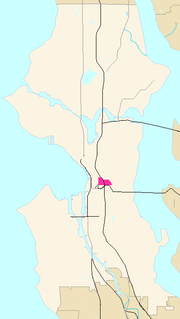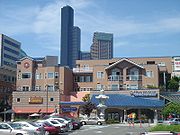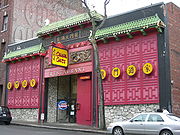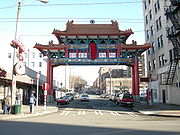
International District, Seattle, Washington
Encyclopedia



Seattle, Washington
Seattle is the county seat of King County, Washington. With 608,660 residents as of the 2010 Census, Seattle is the largest city in the Northwestern United States. The Seattle metropolitan area of about 3.4 million inhabitants is the 15th largest metropolitan area in the country...
, Washington
Washington State
Washington State may refer to:* Washington , often referred to as "Washington state" to differentiate it from Washington, D.C., the capital of the United States* Washington State University, a land-grant college in that state- See also :...
(also known by its component names or simply as the I.D.) is an ethnic enclave
Ethnic enclave
An ethnic enclave is an ethnic community which retains some cultural distinction from a larger, surrounding area, it may be a neighborhood, an area or an administrative division based on ethnic groups. Sometimes an entire city may have such a feel. Usually the enclave revolves around businesses...
neighborhood and is the center of Seattle's Asian American
Asian American
Asian Americans are Americans of Asian descent. The U.S. Census Bureau definition of Asians as "Asian” refers to a person having origins in any of the original peoples of the Far East, Southeast Asia, or the Indian subcontinent, including, for example, Cambodia, China, India, Indonesia, Japan,...
community. The neighborhood is multiethnic, consisting mainly of people who are of Chinese
Chinese American
Chinese Americans represent Americans of Chinese descent. Chinese Americans constitute one group of overseas Chinese and also a subgroup of East Asian Americans, which is further a subgroup of Asian Americans...
, Japanese
Japanese American
are American people of Japanese heritage. Japanese Americans have historically been among the three largest Asian American communities, but in recent decades have become the sixth largest group at roughly 1,204,205, including those of mixed-race or mixed-ethnicity...
, and Filipino
Filipino American
Filipino Americans are Americans of Filipino ancestry. Filipino Americans, often shortened to "Fil-Ams", or "Pinoy",Filipinos in what is now the United States were first documented in the 16th century, with small settlements beginning in the 18th century...
ethnicity. There are also significant populations of people who are of Vietnamese
Vietnamese American
A Vietnamese American is an American of Vietnamese descent. They make up about half of all overseas Vietnamese and are the fourth-largest Asian American group....
, Korean
Korean American
Korean Americans are Americans of Korean descent, mostly from South Korea, with a small minority from North Korea...
, Thai
Thai American
A Thai American is an American of whose parents or grandparents came from Thailand. Many of them may in fact be of Thai Chinese or at least part Chinese ancestry, but they are still considered to be Thais.-History in U.S.:...
, Laotian
Laotian American
A Laotian American is a resident of the United States who was originally from Laos, a person of Laotian descent residing in America, or a citizen born in the United States whose parents were originally from Laos. Laotian Americans are included in the larger category of Asian Americans...
, Cambodian
Cambodian American
A Cambodian American is an American who is born, raised, or from Cambodia usually of Khmer descent but also including Chinese Cambodians, Vietnamese Cambodians, Cham people and other ethnicities of Cambodia...
, and Pacific Islander
Pacific Islander American
Pacific Islander Americans, also known as Oceanian Americans, are residents of the United States with original ancestry from Oceania. They represent the smallest racial group counted in the United States census of 2000. They numbered 874,000 people or 0.3 percent of the United States population...
descent, as well as other communities.
The neighborhood encompasses the blocks east of Fifth Avenue S., beyond which are Pioneer Square
Pioneer Square, Seattle, Washington
Pioneer Square is a neighborhood in the southwest corner of Downtown Seattle, Washington, USA. It was once the heart of the city: Seattle's founders settled there in 1852, following a brief six-month settlement at Alki Point on the far side of Elliott Bay. The early structures in the neighborhood...
and SoDo
SoDo, Seattle, Washington
SoDo is a neighborhood in Seattle, Washington, that makes up part of the city's Industrial District. It is bounded on the north by South King Street, beyond which is Pioneer Square; on the south by South Spokane Street, beyond which is more of the Industrial District; on the west by the Duwamish...
; west of Boren and Rainier Avenues S., beyond which is Rainier Valley
Rainier Valley, Seattle, Washington
The Rainier Valley neighborhood in Seattle, is located east of Beacon Hill; west of Mount Baker, Seward Park, and Leschi; south of the Central District and First Hill; and north of the city line...
; north of S. Dearborn Street, beyond which are Beacon Hill
Beacon Hill, Seattle, Washington
Beacon Hill is a hill and neighborhood in southeast Seattle, Washington. The municipal government subdivides it into North Beacon Hill, Mid-Beacon Hill, Holly Park, and South Beacon Hill, though most people who live there simply call it "Beacon Hill." Home to the world headquarters of Amazon.com...
and the Industrial District
Industrial District, Seattle, Washington
The Industrial District is the principal industrial area of Seattle, Washington. It is bounded on the west by the Duwamish Waterway and Elliott Bay, beyond which lies Delridge of West Seattle; on the east by Interstate 5, beyond which lies Beacon Hill; on the north by S King and S Dearborn Streets,...
; and south of S. Main Street, beyond which is Downtown and First Hill
First Hill, Seattle, Washington
First Hill is a neighborhood in Seattle, Washington, named for the hill on which it is located. The hill, in turn, is so named for being the first hill one encounters traveling east from downtown Seattle toward Lake Washington....
. The main thoroughfares in Chinatown are South Jackson Street and South King Street (east- and westbound); and the prominent thoroughfare in Little Saigon is 12th Avenue South (north- and southbound) intersecting at South Jackson Street. The portion east of Interstate 5
Interstate 5
Interstate 5 is the main Interstate Highway on the West Coast of the United States, running largely parallel to the Pacific Ocean coastline from Canada to Mexico . It serves some of the largest cities on the U.S...
and north of South Lane Street has been dubbed "Little Saigon" because of the high concentration of Vietnamese businesses there.
Hing Hay Park
Hing Hay Park (Seattle)
Hing Hay Park is a public park in the International District neighborhood of Seattle, Washington. It is located at the corner of S. King Street and Maynard Avenue S. The park has a beautiful authentic pagoda in the center of the park, along with benches and chess tables...
, at the corner of S. King Street and Maynard Avenue S., is a popular gathering place in the International District. The Wing Luke Asian Museum
Wing Luke Asian Museum
The Wing Luke Museum of the Asian Pacific American Experience is located in Seattle, Washington's Chinatown-International District. A Smithsonian Institution affiliate, it is dedicated to engaging the public to explore issues related to the culture, art and history of Asian Pacific Americans...
is an important cultural institution in the neighborhood, as was the Nippon Kan Theatre
Nippon Kan Theatre
The is a former Japanese theater in Seattle, Washington, USA. Built in 1909 as a hotel, it was boarded up in 1942 during the Japanese American internment, but reopened in 1981. It is located in the Kobe Park Building at 628 S. Washington Street, in the former Japantown section of Seattle's...
until its recent closure. Kobe Terrace
Kobe Terrace (Seattle)
Kobe Terrace is a public park in the International District neighborhood of Seattle, Washington. It incorporates the Danny Woo International District Community Garden. Named after Kobe, Seattle's sister city in Japan, it occupies most of the land bounded on the west by 6th Avenue S., on the north...
, on the steep slope between I-5
Interstate 5
Interstate 5 is the main Interstate Highway on the West Coast of the United States, running largely parallel to the Pacific Ocean coastline from Canada to Mexico . It serves some of the largest cities on the U.S...
and S. Main Street, is another important site, where many neighborhood residents have urban gardens
Urban agriculture
Urban agriculture is the practice of cultivating, processing and distributing food in, or around, a village, town or city. Urban agriculture in addition can also involve animal husbandry, aquaculture, agro-forestry and horticulture...
in the Danny Woo International District Community Garden. The district includes Uwajimaya Village, named after Uwajimaya
Uwajimaya
Uwajimaya, Inc., doing business as , is a family-owned supermarket chain with its corporate headquarters in the Industrial District, Seattle, Washington, and with locations in Greater Seattle. Uwajimaya sells mainly Asian food—with an emphasis on Japanese—though it also stocks Western staples...
; across Fifth Avenue from Uwajimaya Village is the Union Station
Union Station (Seattle)
Union Station is a former train station in Seattle, Washington, USA, constructed between 1910 and 1911 to serve the Union Pacific Railroad and the Milwaukee Road. It was originally named Oregon and Washington Station, after a subsidiary line of the Union Pacific. Located at the corner of S. Jackson...
office complex, built where abandoned Union Pacific Railroad
Union Pacific Railroad
The Union Pacific Railroad , headquartered in Omaha, Nebraska, is the largest railroad network in the United States. James R. Young is president, CEO and Chairman....
tracks once ran.
According to the 2000 census, the International District is 56% Asian, 15% black, 15% white, and 5% Hispanic/Latino.
History

19th century
Chinese immigrants first came to the Pacific NorthwestPacific Northwest
The Pacific Northwest is a region in northwestern North America, bounded by the Pacific Ocean to the west and, loosely, by the Rocky Mountains on the east. Definitions of the region vary and there is no commonly agreed upon boundary, even among Pacific Northwesterners. A common concept of the...
in the 1850s, and by the 1860s some had settled in Seattle. The first Chinese quarters were near Yesler's Mill
Henry Yesler
Henry L. Yesler was an entrepreneur considered to be Seattle, Washington's first economic father and first millionaire. He arrived in Seattle in 1852 and built a steam-powered sawmill, which provided numerous jobs for those early settlers and Duwamish tribe members...
on the waterfront. In 1886 whites drove out Seattle's Chinese population
Seattle riot of 1886
The Seattle riot of 1886 resulted from anti-Chinese sentiment, which was prevalent in the Western United States during the 19th century. The events culminated in March 1886 but the build-up to the violence began in late summer 1885 as a result of a concerted effort by regional Knights of Labor...
and the Great Seattle Fire of 1889 further hindered the community. Eventually the Chinese established their new quarters further inland along Washington St.
Japanese immigrants also began to arrive, settling in the south side of the district; the part of present-day Dearborn Street between 8th and 12th Streets was known as Mikado Street, after the Japanese word for "emperor." Japanese American
Japanese American
are American people of Japanese heritage. Japanese Americans have historically been among the three largest Asian American communities, but in recent decades have become the sixth largest group at roughly 1,204,205, including those of mixed-race or mixed-ethnicity...
s developed Nihonmachi, or Japantown
Japantown
is a common name for official Japanese communities in big cities outside Japan. Alternatively, a Japantown may be called J-town, Little Tokyo, or Nihonmachi , the first two being common names for the Japanese communities in San Francisco and Los Angeles, respectively.-North America:Japantowns were...
, on Main Street, two blocks north of King Street. By the mid-1920s, Nihonmachi extended from 4th Avenue along Main to 7th Avenue, with clusters of businesses along Jackson, King, Weller, Lane, and Dearborn streets.
20th century

Chinese American
Chinese Americans represent Americans of Chinese descent. Chinese Americans constitute one group of overseas Chinese and also a subgroup of East Asian Americans, which is further a subgroup of Asian Americans...
community, led a group of Chinese Americans to form the Kong Yick Investment Company, a benefit society
Benefit society
A benefit society or mutual aid society is an organization or voluntary association formed to provide mutual aid, benefit or insurance for relief from sundry difficulties...
. Their money and efforts led to the construction of two buildings—the East Kong Yick Building
East Kong Yick Building
The East Kong Yick Building is one of two buildings erected in Seattle, Washington's Chinatown-International District by the Kong Yick Investment Company . A four-story hotel in the core of the ID, with retail stores at ground level, the East Kong Yick was created by the pooled resources of 170...
and the West Kong Yick Building—intended to serve as the anchor of a "new" Chinatown
Chinatown
A Chinatown is an ethnic enclave of overseas Chinese people, although it is often generalized to include various Southeast Asian people. Chinatowns exist throughout the world, including East Asia, Southeast Asia, the Americas, Australasia, and Europe. Binondo's Chinatown located in Manila,...
. Meanwhile, Filipino American
Filipino American
Filipino Americans are Americans of Filipino ancestry. Filipino Americans, often shortened to "Fil-Ams", or "Pinoy",Filipinos in what is now the United States were first documented in the 16th century, with small settlements beginning in the 18th century...
s settled some of the neighborhood's hotels and boarding houses beginning in the early 1900s, attracted by opportunities to work as contract laborers in agriculture and salmon canneries
Salmon cannery
Salmon canneries conduct the commercial canning of salmon. This fish processing industry became widespread on the Pacific coast of North America in the nineteenth century.-List of salmon canneries:Notable salmon canneries and salmon canning settlements...
. Among them was Filipino author Carlos Bulosan
Carlos Bulosan
Also known as Julius Zafra , a Filipino, an English-language novelist and poet who spent most of his life in the United States, and is best known for the semi-autobiographical America Is in the Heart.-Life and career:Carlos Bulosan was born to Ilocano parents in...
who wrote of his experiences in America Is In The Heart
America Is in the Heart
America Is in the Heart, sometimes subtitled A Personal History, is a 1946 semi-autobiographical novel written by Filipino American immigrant poet, fiction writer, short story teller, and activist, Carlos Bulosan...
.
In the 1940s the federal government forcibly detained people of Japanese ancestry in the wake of the attack on Pearl Harbor
Attack on Pearl Harbor
The attack on Pearl Harbor was a surprise military strike conducted by the Imperial Japanese Navy against the United States naval base at Pearl Harbor, Hawaii, on the morning of December 7, 1941...
. Authorities moved them to internment camps
Japanese American internment
Japanese-American internment was the relocation and internment by the United States government in 1942 of approximately 110,000 Japanese Americans and Japanese who lived along the Pacific coast of the United States to camps called "War Relocation Camps," in the wake of Imperial Japan's attack on...
where they lived from 1942 to 1946. Most of Seattle's Japanese residents went to Minidoka in Idaho
Idaho
Idaho is a state in the Rocky Mountain area of the United States. The state's largest city and capital is Boise. Residents are called "Idahoans". Idaho was admitted to the Union on July 3, 1890, as the 43rd state....
. After the war, many returned to the Pacific Northwest but relocated to the suburbs or other districts in Seattle. One remaining vestige of the old community is the office of the North American Post
North American Post
The North American Post is a newspaper based in Seattle, Washington's International District. It was founded in 1902 and is the largest and oldest Japanese-language newspaper published in the Pacific Northwest....
, a Japanese-language newspaper founded in 1902. African Americans moved to the district from across the country to work in the war industry during World War II
World War II
World War II, or the Second World War , was a global conflict lasting from 1939 to 1945, involving most of the world's nations—including all of the great powers—eventually forming two opposing military alliances: the Allies and the Axis...
, occupying many of the houses left vacant due to the interment of the Japanese.
Many neighborhood buildings were destroyed for the construction of Interstate 5
Interstate 5
Interstate 5 is the main Interstate Highway on the West Coast of the United States, running largely parallel to the Pacific Ocean coastline from Canada to Mexico . It serves some of the largest cities on the U.S...
in the 1960s. In the 1970s, organizations devoted to the preservation of the International District were founded, some in response to the 1975 construction of the Kingdome
Kingdome
The Kingdome was a multi-purpose stadium located in Seattle's SoDo neighborhood. Owned and operated by King County, the Kingdome opened in 1976 and was best known as the home stadium of the Seattle Seahawks of the National Football League , the Seattle Mariners of Major League Baseball , and the...
on land that was intended for use as low-income housing. The International Examiner
International Examiner
The International Examiner is a free biweekly Asian American newspaper based in Seattle, Washington's International District. It was founded in 1974 by Gerald Yuasa and Lawrence Imamura to serve what the founders thought were the business interests of the Asian American community in Seattle's...
, a community newspaper, was founded in the district in 1974.
In the late 1970s
1970s
File:1970s decade montage.png|From left, clockwise: US President Richard Nixon doing the V for Victory sign after his resignation from office after the Watergate scandal in 1974; Refugees aboard a US naval boat after the Fall of Saigon, leading to the end of the Vietnam War in 1975; The 1973 oil...
and the 1980s
1980s
File:1980s decade montage.png|thumb|400px|From left, clockwise: The first Space Shuttle, Columbia, lifted off in 1981; American President Ronald Reagan and Soviet leader Mikhail Gorbachev eased tensions between the two superpowers, leading to the end of the Cold War; The Fall of the Berlin Wall in...
, a new wave of immigrants from Southeast Asia
Southeast Asia
Southeast Asia, South-East Asia, South East Asia or Southeastern Asia is a subregion of Asia, consisting of the countries that are geographically south of China, east of India, west of New Guinea and north of Australia. The region lies on the intersection of geological plates, with heavy seismic...
established Seattle's Little Saigon in the district. Many of these immigrants were of Chinese descent.

Wah Mee massacre
The Wah Mee massacre was a mulitiple homicide on February 18, 1983, in which Kwan Fai "Willie" Mak, Wai-Chiu "Tony" Ng, and Benjamin Ng gunned down 14 people in the Wah Mee gambling club. Thirteen of their victims lost their lives, but one survived to testify against the three in the high-profile...
on Maynard Alley on February 18, 1983. Thirteen people lost their lives.
In 1987, the International District gained federal status as the "Seattle Chinatown Historic District"' that was the same year that the Wing Luke Asian Museum
Wing Luke Asian Museum
The Wing Luke Museum of the Asian Pacific American Experience is located in Seattle, Washington's Chinatown-International District. A Smithsonian Institution affiliate, it is dedicated to engaging the public to explore issues related to the culture, art and history of Asian Pacific Americans...
moved to 7th Avenue, a location it would occupy for two decades. In 1999, the City Council
Seattle City Council
The Seattle City Council is committed to ensuring that Seattle, Washington, is safe, livable and sustainable. Nine Councilmembers are elected to four-year terms in nonpartisan elections and represent the entire city, elected by all Seattle voters....
approved the "Chinatown-International District Strategic Plan" for the future of the neighborhood. Since then, the often conflicting interests of development and preservation have clashed as office developments (e.g., Union Station) and market-rate housing development (e.g., Uwajimaya Village) offer economic growth but threaten to change the character of the neighborhood and increase gentrification and rents. A debate over the vacation of S. Lane Street as part of the Uwajimaya redevelopment is an example of this clash.
See also
- Festál at Seattle CenterFestál at Seattle CenterFestál at Seattle Center is a free series of annual ethnically-related festivals that take place on the grounds of Seattle Center in Seattle, Washington. A major cultural program of Seattle, these festivals aim to celebrate and connect the city to its varied ethnic and international community...
, a series of festivals celebrating the culture and contributions of Seattle's various Asian American and other ethnic communities
External links
- Official website of the Chinatown-International District
- International Special Review District from the City of Seattle
- International District from Seattle Post-IntelligencerSeattle Post-IntelligencerThe Seattle Post-Intelligencer is an online newspaper and former print newspaper covering Seattle, Washington, United States, and the surrounding metropolitan area...
- Guide to the International Special Review District Records 1973-1997 from the Northwest Digital ArchivesNorthwest Digital ArchivesNorthwest Digital Archives is an online catalog of descriptive information about the archival collections at various institutions in the Northwestern United States...

